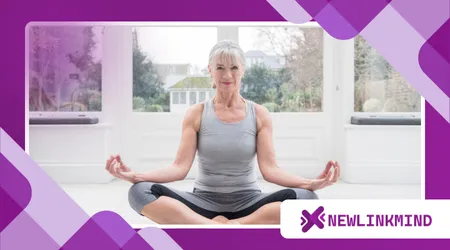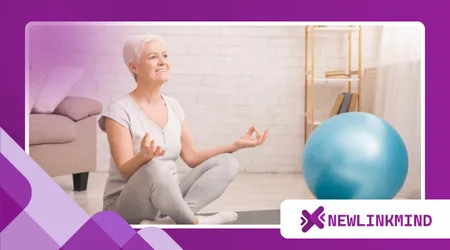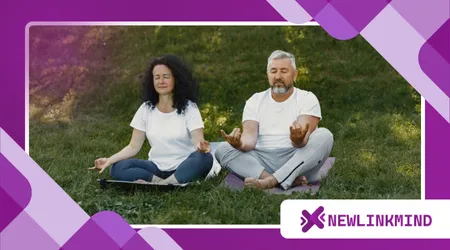How to Create a Peaceful Meditation Space for Seniors

Anúncios
Create a Peaceful Meditation Space for Seniors. Navigating the later stages of life presents a unique blend of experiences, from cherished memories to new physical realities.
As we age, the need for a sanctuary—a personal haven for peace and reflection—becomes paramount.
For many seniors, this sanctuary takes the form of a dedicated meditation space.
Creating this environment isn’t merely about aesthetics; it’s an intentional act of self-care, a way to build a routine that supports mental, emotional, and physical well-being.
A peaceful meditation space becomes a cornerstone for tranquility, allowing seniors to connect with their inner selves and find a sense of calm amidst life’s currents.
Anúncios
The Foundation of Serenity: Choosing the Right Location
Selecting the perfect spot is the first step toward creating a peaceful meditation space for seniors.
Consider an area that is naturally quiet and free from high-traffic noise or distractions.
A corner of a bedroom, a sunroom, or even a quiet nook in the living room can serve as an ideal location.
Anúncios
The key is to find a place that feels private and secure, where external interruptions are minimized.
This deliberate choice sets the stage for a truly immersive and uninterrupted practice.
Once the location is chosen, it’s essential to consider accessibility. The space should be easy to enter and exit, without obstacles that could pose a fall risk.
Ensure there is enough room to move comfortably and that any furniture is stable and supportive. This thoughtful planning ensures the space is not only peaceful but also safe and practical.
Sensory Comforts: Engaging the Senses for Peace
Engaging the senses in a calming way is a powerful technique for creating a peaceful meditation space for seniors. Begin with lighting.
Harsh, fluorescent lights can be jarring; instead, opt for soft, natural light or warm, dimmable lamps.
The gentle glow of a Himalayan salt lamp or a string of fairy lights can also contribute to a serene atmosphere, making the space feel more inviting and tranquil.
Aromatherapy can also play a significant role.
Read more: Breathing Techniques to Reduce Stress for Seniors
The use of an essential oil diffuser with calming scents like lavender, chamomile, or frankincense can help quiet the mind and prepare the body for meditation.
These scents have a direct link to the limbic system, which manages emotions and memories.
The smell of lavender, for example, is widely studied for its relaxing properties and is often associated with promoting sleep and reducing anxiety.

Supportive Elements: Furnishing for Comfort and Stability
The right furniture is crucial for a comfortable meditation practice. For many seniors, sitting on the floor is not an option.
Instead, a comfortable, supportive chair with armrests can provide the necessary stability. Look for chairs with good lumbar support to prevent back strain during longer sessions.
A small, sturdy footstool can also be a valuable addition, helping to elevate the legs and improve circulation.
Check this out: Select the Best Choice That Fits You, get now your credit card
Cushions and blankets add another layer of comfort. A soft blanket draped over the chair or a plush cushion for the back can make the experience much more enjoyable.
Think of it as creating a cozy nest. This focus on physical comfort allows the mind to relax and prevents discomfort from becoming a distraction.
Personal Touches: Making the Space Your Own
A truly peaceful meditation space is one that reflects the individual. Incorporating personal items that evoke a sense of peace and joy can deepen the practice.
Consider including a photo of a favorite place in nature, a small statue of a meaningful figure, or a piece of art that brings a sense of calm.
These objects serve as anchors, grounding the practice in a personal narrative of well-being.
See how interesting: Creating the Perfect Morning Meditation Space at Home
Consider an example: Maria, an 80-year-old artist, transforms a sunlit corner of her home into her meditation space.
She places a small, handcrafted wooden owl on a side table, a gift from her late husband that always brings her a sense of calm.
A framed watercolor painting of a misty forest, a place she visited in her youth, hangs on the wall, inviting her mind to wander into a world of tranquility.
Another example is Robert, a retired engineer, who finds peace in order and simplicity.
His meditation space features a single, comfortable recliner, a small shelf with a few select books on mindfulness, and a tabletop water fountain.
The gentle sound of trickling water, combined with the clean lines of his space, helps him focus and quiet his mind.
Sound and Silence: The Role of Auditory Cues
The auditory environment is a critical component of a peaceful meditation space for seniors. While some may prefer complete silence, others find comfort in ambient sounds.
A small indoor water fountain, a white noise machine, or a playlist of gentle instrumental music or nature sounds can mask external noises and create a consistent, soothing backdrop for meditation.
| Auditory Aid | Benefit |
| Indoor Water Fountain | Provides a gentle, continuous sound that can mask household noises and create a sense of flow. |
| White Noise Machine | Creates a consistent sound that helps block out sudden, distracting noises from outside. |
| Nature Sounds Playlist | Connects the individual to the natural world, fostering a sense of calm and openness. |
| Tibetan Singing Bowl | The unique resonance of the bowl’s sound helps to focus the mind and signal the beginning and end of a session. |
Just as a lighthouse guides a ship through a foggy sea, these auditory cues can guide the mind away from daily distractions and toward a state of inner calm.
They are not distractions themselves but rather tools for focus.

The Mental Sanctuary: Beyond the Physical Space
Creating a peaceful meditation space for seniors isn’t just about the physical setup; it’s about the mental preparation.
It’s a commitment to a routine, a promise to yourself to set aside time for self-reflection.
One study from the National Institutes of Health in 2023 showed that regular meditation practice in older adults can significantly improve cognitive function and reduce symptoms of anxiety and depression.
This highlights the profound impact of not only the space itself but the consistent practice within it. The space is merely the container for the transformative work that happens inside.
It’s a reminder that true peace comes from within, but a supportive environment can make all the difference.
What if we viewed this space not as a luxury, but as a non-negotiable part of our health routine?
This perspective reframes the act of creating this space from a chore into a celebration of self-care. It becomes a ritual, a sacred time set aside for our own well-being.
By designing a physical sanctuary, we are also building a mental one, a place we can retreat to at any time, anywhere.
In conclusion, to create a peaceful meditation space for seniors is to design a haven that supports the journey toward inner calm.
It’s a beautiful intersection of physical comfort, sensory engagement, and personal meaning.
This dedicated space becomes a reliable anchor, a place to return to each day to reconnect with oneself, find balance, and cultivate a sense of deep and lasting peace.
Frequently Asked Questions Create a Peaceful Meditation Space for Seniors
1. É possível meditar sem ter um espaço dedicado?
Sim, é totalmente possível meditar em qualquer lugar. No entanto, ter um espaço dedicado pode ajudar a construir um hábito e a sinalizar ao cérebro que é hora de relaxar e focar.
É como ter um local específico para dormir; embora você possa dormir em qualquer lugar, ter sua cama torna o sono mais fácil.
2. Qual é a melhor hora do dia para meditar?
A melhor hora para meditar é a hora que você pode fazer de forma consistente.
Muitas pessoas preferem a manhã para começar o dia com calma, enquanto outras acham a noite ideal para desestressar antes de dormir. O importante é a regularidade.
3. Preciso de algum equipamento especial?
Não, você não precisa de nenhum equipamento especial para meditar. Um espaço limpo, silencioso e confortável é o suficiente.
Opcionalmente, uma cadeira confortável, almofadas ou um tapete podem melhorar a experiência, mas não são essenciais.
++ Creating a Peaceful Space: Designing aMeditation Area for Seniors at Home
